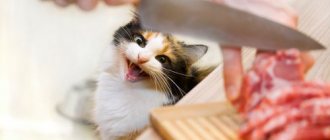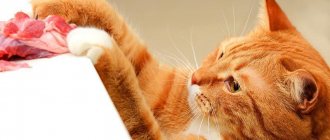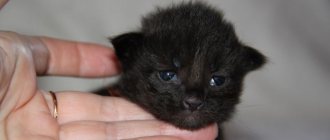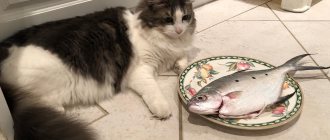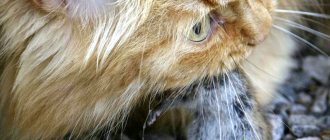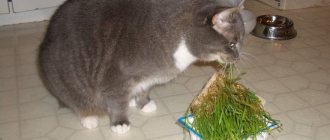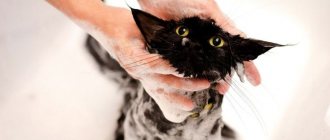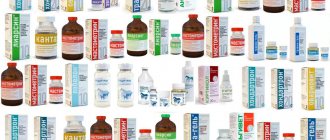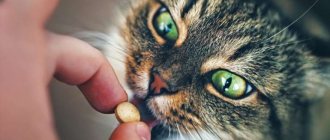Owners of cats and dogs that are fed a natural diet definitely need to think about which source of calcium to choose for their pet. The problem is that mainly phosphorus enters the body with meat: it contains minimal amounts of calcium. At the same time, the balance of calcium and phosphorus in cats’ food should be 1.3:1 or at least 1:1, for kittens – 1.4:1. If you ignore this rule, you can create conditions for the development of serious diseases, such as secondary hyperparathyroidism and others. Therefore, calcium should be supplied with food regularly. Where can I get it?
This article is part of the category Nutritional Supplements for Cats
Deficiency and consequences
At each stage of life, a cat should receive the required amount of calcium appropriate to its age and needs. Without calcium, processes such as the transmission of nerve impulses and muscle contraction are not possible.
Proper calcium intake – in the right amount and at the optimal period. If a cat lacks a microelement, this immediately affects its health, and the consequences are different at each age. For example, if a kitten lacks calcium, then the situation is aggravated by pathologies in skeletal development. Lack of calcium in a cat in adulthood and old age leads to brittle bones - the possibility of fractures increases. Adult pets feel a lack of this element in the fifth month - that is, five months after the body experiences a shortage. In kittens this happens much faster.
It also happens that a cat has high calcium - what to do in this case? Of course, stop giving your cat calcium. It should be remembered that pets at different periods of life require an increased rate of this microelement - especially at a young age, during lactation. Excessive calcium content in a cat’s body is fraught with bone pathology and osteochondrosis.
It is important to adhere to the consumption norm. Is your cat lacking calcium? Use an approximate calculation of consumption - only a veterinarian will provide more accurate information.
- kittens - 440 mg per 1 kg of weight ;
— adult cats – 45 mg per 1 kg of weight .
For example, an adult cat weighing 4 kg should receive 180 mg of calcium per day .
Therapeutic measures
Of course, eclampsia in cats after birth is a serious matter, but with proper and timely treatment, your pet’s life is not in danger. To begin with, the specialist will try to bring down the elevated body temperature (if it is elevated). After this, calcium borogluconate can be administered intravenously to bring the concentration of the substance in the blood to a safe, physiological level.
Sources of calcium for cats
If pets are naturally fed, it is important for the owner to consider where they will get calcium from. As for meat, this is a controversial source of calcium, because most of the phosphorus enters the body with it - but the cat receives very little calcium from meat. It is important to consider the ratio of phosphorus and calcium in the diet. The norm for adults is 1:1.2 or 1:1 . For kittens – 1:1.4 . To the question “ can cats have calcium? ” there is only one answer – it is necessary , and regularly . If, when fed with balanced food, the cat receives its daily requirement - calcium in cat food is necessarily taken into account, then with a natural type of nutrition, all responsibility falls on the shoulders of the owner - it is he who chooses the source of calcium for the pet.
It should also be noted that calcium is not absorbed by cats from foods of plant origin - we have to look for alternative options.
Eggshell: calcium carbonate
Of the natural sources of calcium, eggshells immediately come to mind. Indeed, it consists of 36% calcium. One quail egg shell weighs approximately 1.5 grams. The shell contains calcium carbonate - not the best compound, because... Only 20% is absorbed.
To calculate how many shells a cat needs per day, the daily meat consumption is taken into account. Let's say a cat eats 200g of meat per day, which corresponds to about 400-500mg of phosphorus and about 50mg of calcium. The amount of phosphorus depends on the type of meat (see table below). Accordingly, such a daily dose should contain at least 450 mg of calcium. It turns out that for every 100 grams of meat you need 1 gram of shell (1 shell). An adult cat, eating 200 grams of food per day, should receive approximately 2 quail egg shells. If there is a slight excess, the body will remove it.
The fact that you add shells to your food does not guarantee that calcium will be absorbed by at least 20%, because... the shell still needs to be crushed, preferably into powder: otherwise, in many cats it comes out in pieces along with the feces (the author of the article saw this with his own eyes).
Article continues after advertisement
To increase the amount of calcium absorbed, you cannot pour whole spoonfuls of shells into a plate, because calcium carbonate in large quantities causes side effects: it lowers the acidity of the stomach below normal, causes flatulence, constipation, allergic reactions, and promotes the formation of kidney stones.
Thus, in order to meet your cat’s need for calcium every day throughout his life with the help of shells, you need to count the amount so as not to overdo it too much, but also not to give too little. In addition, due to the low percentage of calcium carbonate absorption, it is advisable to combine the shells with other sources of this mineral. For example, one week a cat may get calcium from the shell, another week from some other source, and so on. Some cats live only on shells without problems - it's better than nothing. However, shells are not an ideal source of calcium for healthy cats.
However, cats with kidney failure who are fed a raw diet are recommended to be fed shells rather than bones. This is due to the balancing of calcium and phosphorus from food. But this is a topic for a completely different conversation. This article is written about healthy cats.
TABLE: phosphorus and calcium per 100 g of product (values in mg)
| PRODUCT | PHOSPHORUS | CALCIUM |
| Hard cheese | 650 | 1000 |
| Eggs (without shell) | 200 | 56 |
| Fish (average) | 300 | 50 |
| Cottage cheese | 150 | 111 |
| Milk | 920 | 1000 |
| Poultry breasts | 310 | 15 |
| Beef liver | 497 | 6 |
| Beef kidneys | 304 | 19 |
| Pork spleen | 283 | 13 |
| Rabbit meat | 263 | 19 |
| Beef heart | 254 | 5 |
| Veal | 250 | 24 |
| horsemeat | 247 | 8 |
| Pork liver | 241 | 10 |
| Pork kidneys | 240 | 13 |
| Beef lean | 237 | 14 |
| Pork fillet | 240 | 22 |
| Venison | 230 | 7 |
| Mutton | 208 | 8 |
| Goat meat | 201 | 17 |
| Pork lung | 186 | 8 |
| Beef lung | 178 | 11 |
| Pig heart | 178 | 7 |
| Pig tongue | 174 | 19 |
| Beef tongue | 145 | 5 |
| Beef tripe | 66 | 81 |
| Pig ears | 24 | 18 |
* The table shows approximate and average data: the content of phosphorus and calcium in certain products varies.
Bones and meat
Meaty bones are a traditional way for cats to obtain calcium. But in this case, you must adhere to certain rules, otherwise you cannot avoid intestinal blockage or other, more serious problems.
However, everyone knows the experience of wild cats - they catch mice and birds, eating them completely - with bones, thereby replenishing the calcium level in the body. Owners feed their tailed pets selectively - mostly boneless meat. So should you give your cat bones?
Bone products are an excellent source of collagen, calcium, chondroitin, and glucosamine.
— Do not give your cat sharp bones, which can injure the intestines and lead to internal bleeding. These are the tubular bones of the wings and legs.
- Cats should not be given medium or large bones - these will get stuck in the esophagus or throat.
- Choose suitable bones with meat from the whole carcass. Alternatively, grind the selected parts in a meat grinder or break into small pieces with a hammer.
— Do not give your cat bones that have undergone heat treatment. When boiling or frying, the chemical composition of the bone changes: protein, vitamins and fat go into the broth, and calcium phosphate loses its digestibility.
When should you take a Calcium (blood) test?
- As part of a comprehensive examination if there is a suspicion of malabsorption of macroelements in the intestine;
- For diseases of the thyroid gland or parathyroid glands;
- Eating disorders, adherence to a strict diet;
- Elderly people when assessing the risk of developing osteoporosis;
- Analysis of the completeness of the diet during pregnancy;
- Detection of multiple ulcers in the stomach and duodenum;
- Additional analysis for urolithiasis and renal failure.
Vitamins with calcium
Veterinary pharmacies offer a large number of calcium preparations for cats. Their selection is carried out in accordance with certain rules:
- do not give drugs “by eye” or for a long time - hypervitaminosis is even worse than a lack of vitamins. Do not ignore the instructions and rules for taking vitamins;
- if the cat eats raw boneless meat, purchase vitamin complexes without phosphorus;
- before constantly taking any drug with calcium, make sure there are no allergic reactions - monitor your pet’s health;
- if the pet is on a special professional food, then it contains all the Vitamins that cats need - taking additional supplements is discussed only with a veterinarian.
Contraindications and side effects
It should not be given to cats if there is an excess of the microelement in the body. If your pet is allergic, then vitamin complexes must be selected with caution, because they quite often cause various reactions. It is not advisable to give medicine to cats if they have kidney disease, hyperparathyroidism and some malignant tumors. It is necessary to choose a complex for kittens with a veterinarian.
Side effects include allergic reactions, nausea, vomiting, and diarrhea. The cat may have a stomach ache and flatulence. Sometimes disorders of the nervous system and psyche appear. If the dosage is too high, hypercalcemia may develop. If your pet experiences any unwanted effects, you should notify your veterinarian. Most likely, the medicine will have to be discontinued.
Calcium supplements for cats
There are several common calcium compounds found in vitamin and mineral supplements for cats.
Calcium carbonate
This compound is found in egg shells and is also found in chalk and shells. Its digestibility is 20% , in addition, side effects are possible with excessive consumption of the supplement. It is better to exclude calcium carbonate from possible options and not consider this calcium requirement for cats.
Calcium gluconate
This is the most famous compound in Russia, but, unfortunately, only 3% . As a vitamin supplement, it is better for cats to replace calcium gluconate with a more suitable option.
Calcium lactate
This is a good calcium compound for kittens up to three months of age, who are still digesting lactose - unlike adult cats. Lactate is contraindicated for cats older than three months - it causes digestive problems.
Calcium citrate
A suitable compound as a vitamin-mineral complex for cats. Digestibility is 44% . This figure is small, but still higher than in the case of calcium carbonate and calcium gluconate. The advantage of use is the low price and the absence of side effects from taking it even if the dosage is exceeded. In the case of calcium gluconate, it is much more difficult to calculate the dosage for a cat.
For dogs and cats, calcium citrate is an optimal dietary supplement.
Calcium chelate
The leader in the digestibility rating is calcium chelate. It is absorbed by the cat's body by 90-98% . This is facilitated by the presence of calcium molecules together with amino acids. With the previously described compounds, the body needs to do additional work - perform long chains of chemical reactions. The cost of the chelate is high, and it is also more difficult to find such an additive. But it's worth it!
Check the prices for vitamins for cat fur - such complexes should be given to cats in courses or on the recommendation of a veterinarian.
Cottage cheese
Calcium for cats is also found in dairy products. However, milk cannot be digested by cats older than 3 months and can cause diarrhea. Cheese is a fairly heavy food for cats and should only be used as a treat. But in terms of calcium, cottage cheese is valuable.
Medium-fat cottage cheese contains 111 mg of calcium and 150 mg of phosphorus per 100 grams. But we remember that the balance of calcium and phosphorus in a cat’s food should be 1.2 (calcium) to 1 (phosphorus) or at least 1:1. Those. in cottage cheese this ratio is not maintained: the bias in favor of phosphorus, as in meat, is simply not as pronounced. And if we take into account that cottage cheese cannot form the basis of the diet and is used only as a small part of it, it turns out that with the help of cottage cheese alone the balance of calcium and phosphorus cannot be achieved. In addition, not all cats agree to eat cottage cheese.
However, this product can be additionally calcified - and such a move can indeed balance the diet. To do this, you need to purchase calcium supplements from a veterinary pharmacy and add them to cottage cheese or other products.
Vitamins for cats with calcium
When it comes to the health and longevity of furry pets, the responsibility falls on the owner - cats and dogs simply have no one else to rely on.
The best vitamins for cats with calcium are natural. Such supplements are balanced in composition and can guarantee good digestibility and effectiveness after a course of administration. In this case, it is completely safe to buy calcium for cats.
| Sea calcium - 1023 rub. | Eggshell powder - RUB 1,259 |
cdVet Fit-Barf Sea Calcium contains one valuable ingredient - limestone from seaweed. This is an excellent option for natural feeding of pets, as it neutralizes excess phosphorus in fresh meat. 100% natural composition guarantees good absorption of the vitamin supplement by cats. We also advise you to familiarize yourself with the prices of vitamins for joints for cats - the calcium content in such preparations is also required.
Fit-Barf Eggshell powder is a natural source of calcium, which fits perfectly into the diet of pets and replenishes the lack of calcium in the body.
| MicroMineral — 1336 rub. | ArthroGreen Classic — 2470 rub. |
Fit-Barf MicroMineral is a mineral feed additive containing seaweed, yeast, malt and grape seed extract. The plant origin of the components is valuable for the body of cats, who receive the supplement daily. They do not overload the detoxification organs - liver and kidneys.
Giving calcium oxalate to a cat is a less attractive idea; vitamins from natural ingredients are another matter.
Bone flour
- Formula: Mainly hydroxyapatite, Ca10(PO4)6(OH)2
- Trade names: Canina Calcina Meat Bone Meal
- Calcium content: 13.6% - Canina supplement, may vary depending on source.
- Phosphorus content: 13.9% - Canina supplement, may vary depending on source.
Often becomes the first choice of the owner. After all, what is a better replacement for bones than bone meal? But it's not that simple. Unfortunately, bone meal differs from raw meat and bone products not for the better, since it is, firstly, a thermally processed product (less digestible), and secondly, it is made from low-quality animal waste.
Most importantly, bone meal's calcium to phosphorus ratio is only 1:1, making it difficult to maintain Ca:P balance in the diet.
Vitamins with calcium for kittens
Kittens require the most calcium. At a young age, active skeletal growth occurs and teeth are formed, so additional calcium supplementation is especially important.
| Milk replacer for kittens - 1260 rub. | FitCroc Cat with reduced protein content - RUB 1,585 | FitCroc Cat - 1994 RUR |
A good idea is to choose premium cat food, in which the calcium level is precisely known, and how much of this microelement the kitten receives per day. In this case, the purchase of additional calcium supplements is discussed with your veterinarian.
Preventive actions
What can (and should) be done to prevent eclampsia in cats? If your cat gave birth for the first time, and the disease struck her immediately after birth, it is better not to risk it: consult a veterinarian who will prescribe special calcium supplements to maintain normal levels of this substance in the blood. The entire time the cat is breastfeeding the kittens, she should be under the supervision of a veterinarian. These measures will not only help prevent recurrent cases of eclampsia! Such actions have a positive impact on the health of both the mother and her offspring.
